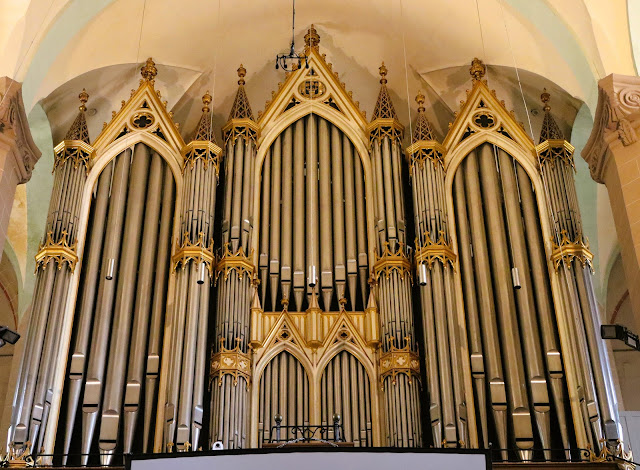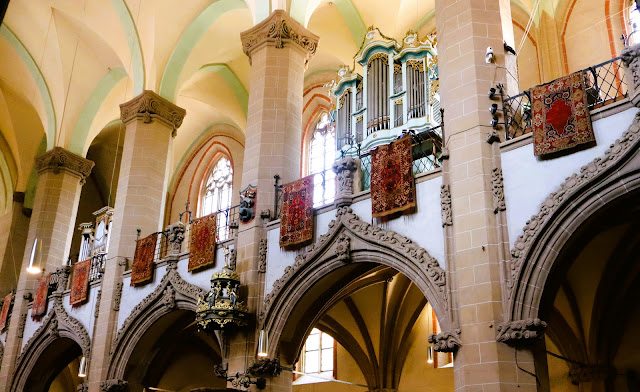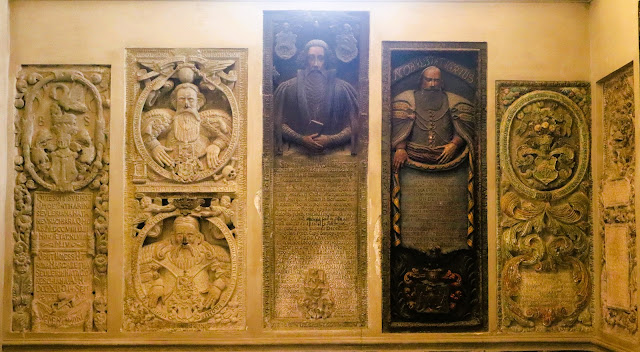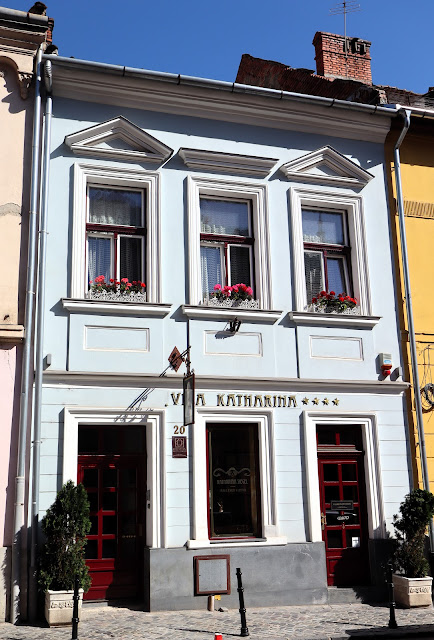At first, we were a little annoyed that our taxi driver dropped us off a street away from our accommodation. Soon, we realize why. We need to walk through (not drive) Strada Sforii (Rope Street), one of the narrowest streets in all of Europe (42 to 48")
This street connects us directly to Old Town, which is very convenient. Our bedroom window is right above Rope Street. At first, we think there is a party below us, then realize that all the tour groups walk the cobbles here.
Much better than tour groups is the legend that Rope Street was a meeting place for lovers whose families did not approve of the match, and that if they kissed here, they would never get apart.
Our first foray into Old Town and we land right at Piata Sfatului (Council Square), the heart of the historic center since 1364. Founded in 1211 and soon settled by the Saxons, it became wealthy from its advantage of being at the intersection of trade routes between the Ottoman Empire and Western Europe.
This huge square is filled with families. It's Children's Day in Romania. There are marathons for different age groups, a climbing wall, balloons, food, art stations for the kids and all kinds of booths, selling items of interest to children. It's a wild time.
In the collage below on the left, we wonder if those are Romanian Barbies?
Brasov became one of the only seven walled citadels in Romania. Some of that wall remains intact today.
Also (mostly) intact but no longer used is one of the five original gates built in 1559 for defensive purposes, Catherine's Gate, named after a monastery originally on the site. The four turrets on the gate told the world that this citadel had judicial autonomy, or 'right of sword' to decide for themselves if a prisoner deserved capital punishment.
And just outside of Catherine's gate, we happen upon another part of town, new to us, and find the St. Nicholas Cathedral a Roman Orthodox church that is likely the oldest one in Romania. There is an arch to go through, several buildings, with murals on their exteriors. We don't get to the interior.
Back of the church.
The wealth is evident in the two large squares and the ornate baroque architecture. The largest church in all of Romania (Biserica Neagra, or Black Church) attracts us like a magnet and after buying tickets to visit, we are in awe of the immensity of its interior, collection of antique rugs and its organ, which is the largest in Eastern Europe. It got its name when the great fire of 1689 blackened its exterior.
One day we climb to Black Tower and look down on Brasov. The enormity of the Black Church becomes evident from this perspective.
Inside the Black Church
The organ.
Part of the collection of ancient rugs.
Churches are considered to be sacred spaces, and at one time, people were buried inside the church so that they could be closer to God. This seemed particularly true for people seeking social status and honour.
A sign tells us that at some point, space constraints and hygienic concerns led this practice to stop, and people were buried in cemeteries, or their bones were placed in an ossuary. A few remain in the Black Church, and here are markers that tell their story.
Need I point out that there is not a woman among them?
Besides the Black Tower in Brasov, there is the White Tower, however, both are painted White, so I had to dig to find the mystery behind their names and appearances. Both towers were built in 1494 as part of the fortification of the citadel.
The Black Tower was hit by lightning in 1559 and caught on fire, thus blackening its white exterior, then, again it caught fire during the Great Fire in 1689, further blackening its walls. Today, the soot has been washed off and the tower is once again white in colour, but not in name.
The White Tower was whitewashed from its beginning and has always remained white.
The walk to the towers from town is along a pretty canal or river (I'm not sure which).
We take the many steps up to the White Tower for a look over Brasov from the viewing platform.
The gondola behind us on the hill is undergoing some renovation, so is not open to the public.
Then we walk a path through the woods to the Black Tower. We merely gazed at it as I was too tired by then to climb yet another long staircase. Later, we figured out that we could have gotten there with a path that was not steep and completely avoided the stairs.
One must go to Bran Castle when visiting Brașov due to its literary connection to Dracula (Vlad the Impaler). A bus runs the route several times a day. So, off we go.
Vlad III was a Prince from Wallachia who may have attacked the castle several times, but never lived there. It's all a fairytale.
Queen Marie of Romania loved this Royal retreat until the communists confiscated it from the Royal Family in 1948. Eventually, it was returned to the Royal Family heirs and acts as a museum to document the times, plus a few kitschy displays of Dracula.
It's worth the trip there, not only to see the castle, but to walk the streets of the pretty mountain town.
Shortly after entering the castle, we need to climb these spooky stairs.
A couple of the rooms in the castle.
Miscellaneous from the Castle
So far on this trip, Brasov has been the city that has resonated the most with us. It's natural setting, smaller size, beautiful buildings, and generally slower pace make it very attractive. In 2024 it made TripAdvisor's Best of the Best list for Trending Destinations.
We try to always use public transportation, but if we had to do it over again, we would probably have rented a car to reach some areas that are too hard to reach with buses and trains, such as Rasnov and Sighisoara.
As usual, we have to post some photos of buildings.
And for fun, a few miscellaneous photos.
See you in Sibiu











































No comments:
Post a Comment